
Books

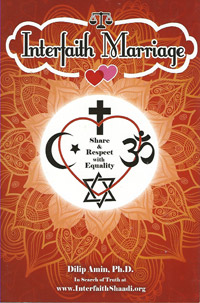 “Interfaith Marriage: Share & Respect With Equality” (310 pages; $14.99) by Dilip Amin; published by Mount Meru Publishing (www.mountmerupublishing.com)
“Interfaith Marriage: Share & Respect With Equality” (310 pages; $14.99) by Dilip Amin; published by Mount Meru Publishing (www.mountmerupublishing.com)
Someone in your family that you know in an interfaith relationship, which could lead to marriage? Then this is the book you must grab for information pertaining to interfaith marriage, conversion, in-law relationships, religious scriptures, and best of all, real-life experiences shared by Hindu, Muslim, Christian, Sikh, Jain and Parsi youth. As the world has shrunk, and rightly so, Dilip Amin points out that in North America, “about a third of the young generation of Dharmics (Hindus, Jains, Buddhists and Sikhs) marry Abrahamics (Christians, Jews and Muslims).” As this trend continues upward, the author forewarns interfaith dating couples to discuss sensitive topics such as religion in the early courting period. He wants interfaith dating couples to be aware of the talking points before making a fully “informed” decision. The journey is never easy, says Amin, but despite all the potential marital pitfalls, a successful and fulfilling inter-religious marriage is possible as long as religious beliefs aren’t forced on the other partner. Other vital questions addressed are: “What religion will my children follow?” “How is the decision to select a faith usually made?” “Is religious conversion for marriage wrong?” “Interfaith relationships should be based on mutual respect for both faiths, and marriage should be solemnized without imposing religious conversion on a spouse,” notes the founder of interfaithshaadi.org and director of Peninsula Multifaith Coalition in San Francisco. “After marriage, both spouse’s faiths should get equal respect and consideration in home life and raising children. Eventually children will find their own solutions to the irreconcilable differences between the two religions.” Before you or somebody you know ties the knot in an interfaith relationship, do check out this book. It is a treasure trove of invaluable information and resources on different religious belief systems.
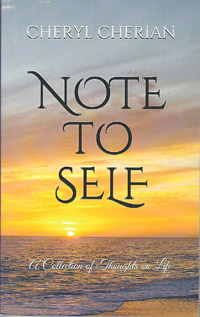 “Note to Self: A Collection of Thoughts on Life: (106 pages; $9.99) by Cheryl Cherian; self-published.
“Note to Self: A Collection of Thoughts on Life: (106 pages; $9.99) by Cheryl Cherian; self-published.
In this debut book, Tampa native and University of South Florida graduate Cheryl Cherian has put together some ramblings and random thoughts on essential life topics such as forgiveness, friends and foes, grief, kindness, identity, positive vibes, relationships, struggles, happiness, etc. “Most of these were little pieces of observations or advice to myself, which in a way were my inspiration,” she notes. Well, the notes could also be motivational for the reader. While admitting that forgiveness can be challenging, she writes, “… it’s what I strive for, for my own peace of mind … Most importantly however, we have to learn to forgive ourselves. Sometimes we are our own greatest critic.” On struggles in life: “Whatever might be your obstacle in life right now, if you challenge yourselves to overcome it, I guarantee that you can meet the countless obstacles to come with the memory of how you overcame this one.” On ‘what ifs”: “Live in the present rather than in fear of the future or what might be. Challenge yourself and watch your fears disappear.” On optimism: “Surround yourself with positive things and positive people, and exuding positive vibes yourself will be that much easier.” On getting real: “Be humble. Nobody likes someone who is boastful. Humility will take you a long way in every situation and with every person you encounter.” On happiness: “If you want happiness, we have to wish happiness for others as well … Happiness is everyone’s birthright. Go out and chase your happiness. Do the things you love that make you happy. Spend time with the people who make you smile. Spread the happiness. Life is too short to not live it to the fullest.” Kudos to Cherian, who is pursuing a Master’s degree in Human Services with a concentration in mental health counseling, for a simple to read and understand self-improvement book.
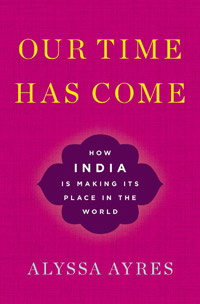
“Our Time Has Come: How India is Making its Place in the World” (340 pages; $27.95) by Alyssa Ayres; published by Oxford University Press (www.oup.com/us)
India is on the march and there is just no stopping the third largest economy (GDP PPP share of world total), the third biggest military and by 2022, the most populous country in the world. So points out the author, who served as U.S. deputy assistant secretary of state for South Asia from 2010-2013. Of course, India has several vulnerabilities, notes Ayres, such as being home to the largest number of the world’s poor, strained infrastructure in dire need of repair, social discrimination and religious tensions, and its location in a tough neighborhood with Pakistan and China presenting challenges at every turn. While recognizing that Pakistan is a security threat, she writes with assurance, “Pakistan-based terrorist groups can do harm, but they cannot alter the fundamental transformation that has now positioned India among the world’s largest economies and with a significant contribution to global democracy, peace and security, development, and governance.” As India and America are drawn closer, she has several suggestions for the world’s sole Superpower such as developing stronger bilateral ties, expanding technical partnership with India on democracy, etc. Just as importance is given to countries like Japan, China, Russia, Brazil, India’s significance to U.S. national interests should also receive some spotlight, she suggests. “India, as a major rising power of Asia, should be better understand better appreciated in its own terms—as a competitiveness issue for U.S. economic and business interests, and as a matter of the demands of the new global diplomacy in which all of Asia plays a much more pivotal role,” writes Ayres. Whether you are an Indophile or not, this is a book to treasure as India moves toward “making its place in the world.” Against all odds.
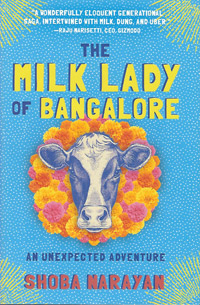 “The Milk Lady of Bangalore: An Unexpected Adventure” (256 pages; $24.95) by Shoba Narayan; published by Algonquin Books (www.algonquin.com, www.shobanarayan.com)
“The Milk Lady of Bangalore: An Unexpected Adventure” (256 pages; $24.95) by Shoba Narayan; published by Algonquin Books (www.algonquin.com, www.shobanarayan.com)
After 20 years in the U.S., the author and her family return to India. One fine day, she comes across a cow in the elevator of her modern high-rise apartment building. There it stood, angled diagonally to fit, not looking uncomfortable, merely impatient and tethered to its owner, Sarala, the milk lady who sells milk right across the apartment. “It is for the housewarming ceremony on the third floor,” reveals Sarala. The two quickly become close friends, which kicks off a wild adventure in search of a new milk cow. Though both women come from diverse backgrounds, they bond together. Along the way, the reader is treated to a history lesson of the cow in Indian culture and life in general as well. With a dose of wild humor. “Cows may foretell death, but they also give life.” “Cows are not slow; they are just deliberate. Cows don’t linger; they rush to their calves like a river rushes to sea.” “The Sanskrit word for cow is go, and cows are venerated as Go-matha, or ‘Cow-mother.’ ” “Milk is my way of reconnecting with the patch of earth that I call home.” “There are certain explanations that you can use with impunity in India – traffic jams and power cuts being two of them. I plunge in with the delicacy of an assassin.” “Is grief a luxury that the poor cannot afford, caught as they are in the business of making ends meet?” “I hate goodbyes. Always have. Goodbyes are guilt on steroids.” We too hated saying goodbye to this superbly written and stirring book by Shoba Narayan. This one deserves a spot on your must-read list for the year.
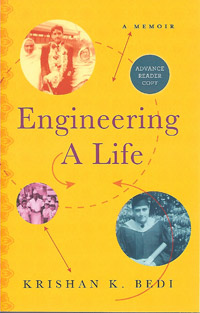 “Engineering a Life – A Memoir” (312 pages; $16.95) by Krishan K. Bedi; published by Spark Press (www.gosparkpress.com)
“Engineering a Life – A Memoir” (312 pages; $16.95) by Krishan K. Bedi; published by Spark Press (www.gosparkpress.com)
He may not be a household name but his story of perseverance and resolve is a tremendously stirring read. At just 20 years of age, Krishan Bedi left India and landed at a port in New York after a three-week journey by sea. The year was 1961 and you can imagine the culture shock he faced while beginning his new life in Knoxville, Tenn. To make ends meet and fulfill his dreams, he did it all: janitor, dishwasher, cook, commercial laundry employee, city transit bus driver. Finally, he earned a master’s degree in industrial engineering at the University of Tennessee. It was then back to India where the author married Raj before returning to the U.S. to become a successful healthcare executive. In the beginning, disillusioned by the process of applying to become a student in the U.S., his mother advised him, “Krishan, if you really want something, you should not give up simply because it is too hard. Please, you have my blessing to try again.” And he did, with success. Even after a move-back to India with the entire family for a new hospital administrator’s job didn’t pan out, he wasn’t disheartened. He carried on. Today, he resides in Peoria, Ill., with his wife Raj. Bedi has three sons and five grandchildren. He ends on a convincing note, “I have learned to not worry about uncertainties, but instead, to do my best and leave no stone unturned.” His tale is the very essence of the American Dream, truly an inspiration for the young.
CORAL SPRINGS AUTHORS SPOTLIGHT FREEDOM STRUGGLE, KARMA
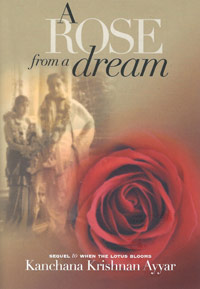 “A Rose from a Dream” (362 pages; $19.99) by Kanchana Krishnan Ayyar; published by Kanchi Books (www.kanchibooks.com)
“A Rose from a Dream” (362 pages; $19.99) by Kanchana Krishnan Ayyar; published by Kanchi Books (www.kanchibooks.com)
In the prequel, “When the Lotus Blooms,” Kanchana Krishnan Ayyar took the reader on a journey to British Colonial India while following the lives of two child brides. There’s Rajam who is fighting her failure to conceive, tormented by a dominant mother-in-law. And Dharmu, who is struggling to adjust to her husband’s Westernized life. In this sequel, “A Rose from a Dream,” the Coral Springs resident brings together the two mothers’ respective families, and their children Kamu and Kandu amid the backdrop of turbulent times. Such as the catastrophic Great Bengal famine of 1943 in which three million people died and the horrific Calcutta riots of 1946. The author introduces several intriguing characters, including brown sahibs, who struggle to show loyalty to the crown while keeping their patriotic feelings in check; revolutionaries, out for revenge; and probably the most colorful and interesting of all, the devadasis, among the forgotten lot today. Amid the upheaval of the battle for freedom, the author lays the foundation to unite the two families of distinctly different upbringings. And we must point out, she has done a superb job of weaving the lives of the rich and poor into a fine, gripping story. It is no easy feat to capture the essence and chaos of the longing for freedom. A native of New Delhi, Ayyar lived in Mexico City, Buenos Aires and New York City before moving to Coral Springs in 1999. Her other book credits include “The Present: A gift from the Divine” and “Snapshots.”
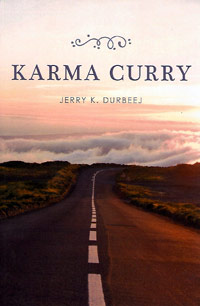 “Karma Curry” (296 pages; $14.95) by Jerry K. Durbeej; published by CreateSpace Independent Publishing Platform (www.createspace.com)
“Karma Curry” (296 pages; $14.95) by Jerry K. Durbeej; published by CreateSpace Independent Publishing Platform (www.createspace.com)
Set in the 1970s, this story takes you on a journey from village life in Guyana’s capital, Georgetown, to New York City. The story is simple but told beautifully by the author Jerry K. Durbeej, another resident of Coral Springs. Karamchand, the eldest son of Raman and Raani Mohandas, is engaged to Priya, daughter of Bharat and Sunita Etwaroo, who live in Mortice. However, the 21-year-old backs away from marriage and deserts his fiancée by taking off for New York City. But it is not just Priya who suffers this fate. Another woman, Gaitri Kumar, also falls to hopes Karamchand has shown in their relationship. As they say, what goes around comes around. And it does when both Gaitri and Priya end up in America about four years later. It appears Karam’s karma has caught up with him when one fine day, he is deported back to Guyana by U.S. immigration authorities for being an illegal alien. Durbeej brings out Karam’s mixed but sad emotions and feelings on the plane back to his motherland. “Twilight. Men leaning on polished akyah sticks, women squatting separately on the clay floor daubed weekly with mud and cows’ dung; the smell of smoke from fires repelling mosquitoes from the sheep and cows, the scent of strong bunjal curry wafting through the air, and the sad Hindi songs yearning for the return of lost love, lost friendship, or lost gods. India kept calling …” For a debut book, this is well written with all the hodgepodge of love, despair, heartbreak, revenge, passion, betrayal, remorse, ambition, and, of course, karma. We hope Durbeej has more such fascinating books in store for us.
CUISINE
 “Bollywood Kitchen: Home-cooked Indian Meals Paired with Unforgettable Bollywood Films” by Sri Rao; photography by Sidney Bensimon; 310 pages; $25; published by Houghton Mifflin Harcourt (www.hmhco.com)
“Bollywood Kitchen: Home-cooked Indian Meals Paired with Unforgettable Bollywood Films” by Sri Rao; photography by Sidney Bensimon; 310 pages; $25; published by Houghton Mifflin Harcourt (www.hmhco.com)
 This is probably the most unique and rather unusual cookbook we have read and reviewed. While providing simple and straightforward recipes, the author takes the reader on a guided tour of Bollywood films such as “Guru,” “Kahaani,” “Queen,” “Devdas,” “Lagaan,” among others. In Sri Rao’s opinion, these are the best contemporary Bollywood films. And the 69 recipes, all credited to his mother, are paired with the movies and use simple, American ingredients. “The result is homemade Indian food you’ll enjoy sharing with your family and friends because it’s delicious, healthy, and easy to prepare.” For example, with “Kapoor & Sons,” Rao recommends dinner of Geeta’s Roast Chicken (whole chicken marinated in Spicy Yogurt and Nuts), Sweet and Savory Pumpkin (simmered with Indian Green Chilies, Sesame, Coconut, and Brown Sugar) and Bagara Annam (tasty Cashew Fried Rice). Each film has a Flavor, Recipe, The ‘Dish’, ‘Ingredients’ and ‘Taste This’ description. In other words, he introduces a film, explains why readers will love it, and reveals juicy details from behind the scene. There also are suggestions on similar Bollywood movies to watch if you are interested. Other fascinating film pairings include a dinner of Bollyburgers (succulent, spicy hamburgers with Mango salsa) with “Gangs of Wasseypur,” brunch of Dosas (crispy lentil-rice crepes) with “Dil Se,” Cocktail Kofta (mini meatballs in creamy cashew sauce) with “Dabangg,” and Chicken Korma (chicken breasts smothered in rich yogurt sauce with almonds and raisins) with “Bajirao Mastani.” Interspersed with captivating film and recipe photographs, the book is a “dinner and a movie” treat for the reader. In Technicolor, we must add.
This is probably the most unique and rather unusual cookbook we have read and reviewed. While providing simple and straightforward recipes, the author takes the reader on a guided tour of Bollywood films such as “Guru,” “Kahaani,” “Queen,” “Devdas,” “Lagaan,” among others. In Sri Rao’s opinion, these are the best contemporary Bollywood films. And the 69 recipes, all credited to his mother, are paired with the movies and use simple, American ingredients. “The result is homemade Indian food you’ll enjoy sharing with your family and friends because it’s delicious, healthy, and easy to prepare.” For example, with “Kapoor & Sons,” Rao recommends dinner of Geeta’s Roast Chicken (whole chicken marinated in Spicy Yogurt and Nuts), Sweet and Savory Pumpkin (simmered with Indian Green Chilies, Sesame, Coconut, and Brown Sugar) and Bagara Annam (tasty Cashew Fried Rice). Each film has a Flavor, Recipe, The ‘Dish’, ‘Ingredients’ and ‘Taste This’ description. In other words, he introduces a film, explains why readers will love it, and reveals juicy details from behind the scene. There also are suggestions on similar Bollywood movies to watch if you are interested. Other fascinating film pairings include a dinner of Bollyburgers (succulent, spicy hamburgers with Mango salsa) with “Gangs of Wasseypur,” brunch of Dosas (crispy lentil-rice crepes) with “Dil Se,” Cocktail Kofta (mini meatballs in creamy cashew sauce) with “Dabangg,” and Chicken Korma (chicken breasts smothered in rich yogurt sauce with almonds and raisins) with “Bajirao Mastani.” Interspersed with captivating film and recipe photographs, the book is a “dinner and a movie” treat for the reader. In Technicolor, we must add.
Here are just two of the recipes reproduced with permission from the publisher:
-Sidney-Bensimon.jpg) Sri’s Signature Chicken
Sri’s Signature Chicken
I can’t decide if I have a favorite movie in this book, but English Vinglish is certainly near the top. Likewise, if there’s only one recipe you take with you from this book, my signature chicken curry should be it. Every home has a go-to chicken dish—the one that you make more than any other, that pleases everyone in the family, and that you’re proud to serve to guests. This is that dish in my house.
I’m incredibly satisfied with this recipe just as it is, rich with spice and flavor, but you can also view it as a base from which to create slightly different curries. For a creamy variation, swap the coconut powder for 2 tablespoons of Greek yogurt. Or for a saucier version, add one finely chopped tomato after you’ve sautéed the onion (and skip the coconut). In fact, if you choose to cook with chicken breasts instead of thighs, I recommend opting for one of these variations because they’ll provide more moisture for the lean meat. (I also suggest reducing the amount of time you cook the chicken by about 10 minutes.)
This recipe, like all curries, is inevitably better the day after you’ve cooked it, once the spices have had a chance to soak even deeper into the meat. So make it a day ahead if you can. Once you get the hang of it, you could easily be cooking Sri’s Signature Chicken every week . . . at which point, you’re welcome to call it your signature chicken.
SERVES 4 to 6
- 2 tablespoons canola oil, divided
- 2 pounds boneless, skinless chicken thighs, cut into 1½-inch chunks
- 1 teaspoon ground turmeric
- 2 bay leaves
- 1 large onion, finely chopped
- 2 tablespoons garlic paste (or minced garlic)
- 1 heaping tablespoon ginger paste (or minced ginger)
- 1/2 tablespoon salt
- 1 teaspoon Indian red chilli powder (or cayenne)
- 3/4 teaspoon ground cinnamon
- 3/4 teaspoon ground cloves
- 1/2 cup chopped cilantro
- 1/2 cup coconut powder
- 1/2 tablespoon ground coriander
- Lemon wedges, for garnish
- Onion slices, for garnish
- Cooked rice (any type), for serving
Heat 1 tablespoon of the oil in a Dutch oven or heavy saucepan over medium to medium-high heat. Season the chicken pieces with the turmeric. In multiple batches (to prevent crowding the pan), lightly brown the chicken on all sides. Remove to a plate.
Heat the remaining 1 tablespoon oil in the pan and add the bay leaves, allowing them to begin infusing the oil for 15 seconds. Add the onion and cook, stirring, until golden brown, reducing the heat if necessary to prevent burning, 7 to 10 minutes.
Add the garlic and ginger pastes and cook, stirring, for 2 minutes. Then add the salt, red chilli powder, cinnamon, and cloves. Stir the spices into the onion, allowing them to bloom for another minute. Return the chicken to the pan. Stir well to coat all the pieces evenly with the spice paste. Decrease the heat, cover, and simmer, stirring occasionally while scraping up the brown bits from the bottom of the pan, for 15 minutes.
Remove the bay leaves. Stir in the cilantro, coconut powder, and coriander. If you’re making the dish a day ahead, turn off the heat at this point. Cool before refrigerating and then finish cooking before you serve.
Decrease the heat to the lowest setting, cover, and continue cooking for another 15 minutes.
Stir well. Adjust the seasonings to taste. Turn off the heat and allow the meat to rest for 10 minutes. Garnish with the lemon wedges and slices of onion. Serve with rice.
Sri’s Signature Chicken from Bollywood Kitchen by Sri Rao. © Copyright 2017 by Sri Rao. Used by permission of Houghton Mifflin Harcourt. All rights reserved.
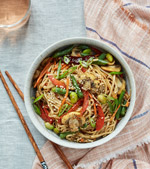 Vegetable Hakka Noodles
Vegetable Hakka Noodles
INDO -CHINESE VEGGIE LO MEIN
Rani and Vijay’s endearing first date in a Chinese restaurant reminded me of something. I realize I may offend over a billion people when I say this, but I have to confess: the most delicious Chinese food I’ve ever eaten has been in India.
It may come as a surprise to a lot of people, but India has amazing Chinese food. The two ancient cultures have shared centuries of trade (and conflict) due to their close proximity, so it makes sense that there has been significant culinary crossover as well. Today, Chinese food is incredibly popular in India, enjoyed by middle-class families and couples on date nights, just like Rani and Vijay.
But Indians’ version of Chinese food is different from what we have in America (or, for that matter, authentic Chinese food in China). Indo-Chinese cuisine melds Chinese cooking techniques with Indian spices to create dishes that I absolutely adore, like Chilli Chicken, Gobi Manchurian, and this dish—Vegetable Hakka Noodles.
This simple veggie lo mein can be made with any combination of vegetables that you have on hand. Just make sure they’re thinly sliced to make for quick cooking. You’ll find that the spices in this dish are bolder than your traditional American lo mein. Garlic, ginger, and red chillies create a flavor profile that’s reminiscent of takeout Chinese, but with a fiery, Indian twist.
SERVES 4
- 8 to 10 ounces lo mein (or spaghetti) noodles
- Extra-virgin olive oil
- 2 tablespoons canola oil
- 2 or 3 Indian dried red chillies
- 2-inch piece fresh ginger, thinly sliced
- 1/2 tablespoon garlic paste (or minced garlic)
- 1/2 cup sliced scallions (white and green parts, about 4 scallions), plus extra for garnish
- 1/2 cup thinly sliced bell pepper (about 1/2 pepper)
- 1/2 cup peeled and thinly sliced carrot (about 1 large carrot)
- 1/2 cup chopped green beans
- 1/2 cup sliced mushrooms
- 1/2 cup lima beans or edamame
- 2 tablespoons soy sauce
- 1/2 tablespoon rice vinegar
- 1 teaspoon sesame seeds
- 1/4 teaspoon freshly ground black pepper
- Pinch of sugar
Bring a large pot of salted water to a boil. Add the noodles and cook until al dente, following the instructions on the packet. Drain well and rinse briefly under cold tap water. Then drizzle with a bit of olive oil to keep from sticking.
Heat the canola oil in a wok over medium-high heat. Add the red chillies, ginger, and garlic paste and cook, stirring, for about 30 seconds. Then add the scallions, bell pepper, carrot, green beans, mushrooms, and lima beans. Cook over high heat, stirring, until the carrot is tender, 3 to 5 minutes.
Add the pasta to the wok along with the soy sauce and vinegar. Using tongs or two spoons, toss the pasta with the veggies for a few minutes, until well incorporated. Sprinkle with the sesame seeds, black pepper, and sugar along the way.
Adjust the seasonings to taste. Transfer to a serving platter or bowl. Garnish with chopped scallions. Be sure to warn your guests about the chillies!
Vegetable Hakka Noodles from Bollywood Kitchen by Sri Rao. © Copyright 2017 by Sri Rao. Used by permission of Houghton Mifflin Harcourt. All rights reserved.
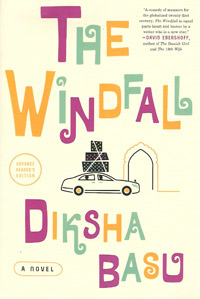
“The Windfall” (296 pages; $26) by Diksha Basu; published by Crown Publishing Group (www.crownpublishing.com/)
Meet Anil and Bindu Jha, a middle-class couple living in a raucous, dilapidated housing complex with a troubled son Rupak, studying business in the United States. Anil is thrilled to sell his online business for a $20 million windfall. His joy knows no bounds. Even more so than his wife’s. He immediately buys a Mercedes and an expensive home in Gurgaon, a Delhi suburb. The best parts of the book are the interactions of the Jhas with their old and new neighbors. When Anil points out to his new neighbor Dinesh Chopra that his son studies in upstate New York, Ithaca, where Cornell University is, the all-knowing Chopra replies, “Ithaca. That is a town in Italy if I am not mistaken … I am a big fan of Michelangelo.” There are sparkles of subtle humor and wit throughout, one during Bindu’s first trip to the new neighborhood. “The only sign she had seen of people on this road was a passing blue Aston Martin with such darkly tinted windows there was no way of knowing if there was a dog driving this car. A year ago she wouldn’t even have known what an Aston Martin was.” This gem of a complaint to his wife from Anil when visiting the shoe handler at a temple had us in splits. “They’re robbing people blind with the shoe check-in. I’ll leave one shoe outside the temple and keep one in my back pocket—nobody will steal a single shoe.” All in all, “The Windfall” is a fun read that will leave you cackling every now and then. It’s been termed a “comedy of manners.” And rightly so.
“The Epic City: The World on the Streets of Calcutta” (272 pages; $27) by Kushanava Choudhury; published by Bloomsbury (www.bloomsbury.com)
It doesn’t matter if you have been to Calcutta. This part memoir and autobiography by Kushanava Choudhury etches before one’s eyes a legendary city of great hopes and sunken dreams. Born to Indian American scientists in New York, the author and his family migrate between India and America at least four times before settling in Highland Park, N.Y. After graduation from Princeton, he moves to Calcutta in 2001 where “The past is never left behind. It haunts every world you live in. Sometimes it drags you back.” Choudhury vividly paints a picture of the city: “The mildewed concrete buildings, the bowl-shaped Ambassador taxis, the paintings on the backs of buses, the ubiquitous political graffiti, the posters stuck onto any flat surface, the bazaars full of squatting fish sellers, the tea shop benches on the sidewalks, the caged balconies of the middle classes, the narrow entrails of corrugated slums, nothing had changed, not even the impassive expressions on the faces of clerks. The city was in its own time zone.” Believing that “an account of the past should help a people to understand its present in order to imagine a shared future,” he recounts with repulsion the Hindu-Muslim riots during partition and the great Bengal famine. “No monument remembers those pasts, which have been willfully forgotten.” Not everything is doom and gloom in Calcutta as the author introduces us to publishers of literary magazines who have a Bengali love for the arts or catches up with unknown but talented poets. Join Choudhury as he enters “countless portals of the city, following streets upon streets, pavements upon pavements, to another life” in the epic city. You will enjoy the journey like we did.
 “Shared Tables: Family Stories and Recipes from Poona to LA” by Kaumudi Marathe; 302 pages; $14.18; published by Speaking Tiger Books; (www.speakingtigerbooks.com)
“Shared Tables: Family Stories and Recipes from Poona to LA” by Kaumudi Marathe; 302 pages; $14.18; published by Speaking Tiger Books; (www.speakingtigerbooks.com)
The Konkanastha and Saraswat cuisines may be poles apart in every respect but can easily stir an appetite or two. Like they did for us as Kaumudi Marathe related stories dating back to her roots in the two clans. We read anecdotes (not just about food but also crossing social barriers, caste, creed) of some fascinating time spent with her maternal and paternal grandparents. The reader is then taken on a ‘flavorful’ tour of Poona, Canada, Nagaland, Hyderabad and Wales before the author settles in Bombay as a journalist covering fires, interviewing Amitabh Bachchan, meeting Mother Teresa and writing her first book, “Temples of India: Circles of Stone.” Marriage transports the author to Texas and then Los Angeles where she settled down and started Un-Curry (www.un-curry.com), a catering company, cooking school and pop-restaurant, unlike any other. “I wanted people to move past the idea of Indian food being greasy, spicy-hot food you got for cheap in a dive. I wanted them to explore beyond samosas, tandoori chicken, naan and tikka masala, which were all delicious but only represented a tiny portion of India’s rich culinary diversity,” she writes. Now, who would deny that? Cooking classes allow Marathe to share stories, history, folklore and a good meal with people who want to learn about Indian food. She nixes the belief that all Indian food is spicy. “Before we had chillies, we used black pepper and ginger.” At the end of the book, she skimps on her favorite recipes. We could have used some more of the “un-curry” ones. The author of two other books, “The Essential Marathi Cookbook” and “Maharashtrian Cuisine: A Family Treasury,” remembers her grandmother’s words loud and clear. “Tell the stories you’ve been gathering all your life. Say the things I never got to say.” Marathe would make grandmother Veerbala proud for “hearing family stories, documenting the past, cooking traditional Marathi food from recipes shared by older generations to revive flavours not often tasted today.”
Here are two recipes reproduced with permission from the author:
Marathe Clan: Konkanastha Braised Okra with Tamarind and Jaggery
Serves: 2-4; Time: 30 minutes
My great-aunt Susheela Marathe shared this unusual Konkanastha recipe for okra with me when I was researching my first cookbook.
Ingredients:
- ¼ kg okra/bhendi, washed, well-dried and stemmed
- 1 tablespoon (tbsp) vegetable oil
- ½ teaspoon (tsp) mustard seeds
- Pinch of asafoetida
- Pinch of turmeric
- 2 tbsp tamarind pulp
- 2-inch lump of jaggery, grated
- 2-3 tbsp water
- ¾-1 tsp salt
- 3-4 sprigs coriander leaves
Method:
- Chop okra into ¾-inch long pieces.
- Heat oil in a medium wok.
- Pop mustard seeds. Stir in asafoetida and turmeric.
- Sauté okra over medium-high heat for 2-3 minutes.
- Stir in tamarind, water and jaggery.
- Reduce heat and cook covered, stirring occasionally, 12-15 minutes.
- Add salt and cook uncovered 2-3 minutes to evaporate most of the water.
- Serve hot, garnished with coriander leaves.
Sirsikar Clan: Saraswat Pan-Fried Pomfret
Serves: 2-4; Time: 30 minutes marinating + 30 minutes cooking
The Saraswats love fish and I am no exception. Vahini's fried pomfret makes a delicious appetizer. If pomfret is not available, try it with thin fillets of firm, white fish like tilapia, cod, or turbot, even shrimp.
Ingredients
- ½ kg pomfret or other firm-fleshed white fish fillets, washed & patted dry
- 2 tsp salt
- 3 tsp turmeric
- 50 grams fine rice flour
- 2 ½ tsp red chilli powder
- ¼ litre vegetable oil lime wedges for garnish
Method
- Rub fillets with salt and turmeric 30 minutes before frying.
- Spread rice flour in a small plate.
- Heat 2-3 tablespoons oil on the griddle till very hot, 4-5 minutes.
- Sprinkle some red chilli over each fillet and transfer it to the rice flour, pressing down to coat both sides evenly.
- Shallow-fry 6-8 coated fillets at a time, 3-5 minutes per side.
- Drizzle a little oil around them as they cook.
- Turn fillets when the first side is firm and golden brown.
- Replenish oil as needed.
Drain well before serving hot with lime wedges and sliced onions.
“The Strange Disappearance of a Bollywood Star” (386 pages; $15.99) by Vaseem Khan; published by Redhook (www.hachettebookgroup.com)
After “The Unexpected Inheritance of Inspector Chopra” and “The Perplexing Theft of the Jewel in the Crown” comes another gem from Vaseem Khan. In the latest Baby Ganesh Detective Agency mystery series book, retired Inspector Ashwin Chopra solves the case of a kidnapped, rebellious Bollywood actor Vicky Verma. As always, he is aided by his adorable wife Poppy, Irfan (former street urchin but now a bona fide Chopra family member), Baby Ganesh and ex-police colleague Rangwalla, who gets a fascinating sub-plot of his own that involves flamboyant eunuchs and a long-buried, hush-hush family story. Like previous books by Khan, there are several twists and turns, one even lands Chopra in a rural prison for hardcore criminals. Once again, we have Baby Ganesh to the rescue. Truly, Bombay, now Mumbai, comes back to life as in: “Caste prejudice, religious prejudice, social prejudice, prejudice in all its myriad forms.” And we couldn’t agree more with Khan on this vivid description of Film City studio in Goregaon. “Serving as a canvas to the unbridled creativity of legendary art directors and megalomaniac producers, Film City had played host to every manifestation of Indian life imaginable. There were lakes, hills, deserts, clifftops, fake villages, and miniature cities. Mughal palaces rubbed shoulders with modern skyscrapers and seedy dance bars.” Hats off to the author for yet another enchanting crime mystery. We await, patiently (or impatiently!), for the next in the Baby Ganesh Detective Agency series.
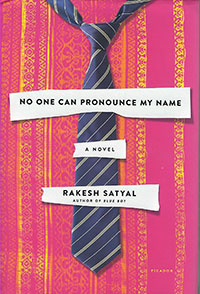 “No One Can Pronounce My Name” (400 pages; $26) by Rakesh Satyal; published by Picador Hardcover (www.picadorusa.com)
“No One Can Pronounce My Name” (400 pages; $26) by Rakesh Satyal; published by Picador Hardcover (www.picadorusa.com)
The story is straightforward but the characters are passionately complex. In a suburb outside Cleveland lives Harit in his mid-40s along with his mother. Since the untimely death of his sister, Harit has been dressing up in a sari daily to pass himself off as the deceased Swati. He believes this imprudent attempt is the only way to stay sane and keep his nearly-blind mother somewhat normal too. Employed at a men’s clothing store, he is close friends with a gay coworker Teddy. Not too far away is Ranjana, another immigrant in mid-40s, who is married to Mohan. The two have a son, Prashant, who is studying chemistry in college. Ranjana, who works as a receptionist at a doctor’s office, incorrectly believes that her husband is having an affair and seeks solace by writing paranormal romances in secret. Satyal sets up the characters and their backgrounds eloquently before Harit and Ranjana meet to stir up a friendship of sorts, among many other feelings. The author can be wildly hilarious. “He had a common Indian male physique: second trimester with a possible sail into the third,” he notes about a character. Or here’s another: “It’s just that, well, I’m Indian, and I’d be killed by firing squad if I don’t study science.” And two specifically about Harit: “It was enough to send him screaming back into his sari.” “Uncles were supposed to wear dress shirts—open at the collar—the skeletal silhouette of a T-shirt underneath them, and some gigantic wristwatch.” Despite rampantly confused characters, Satyal articulates their lives in a witty and insightful manner.
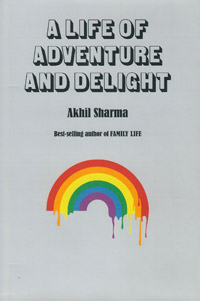 “A Life of Adventure and Delight” (202 pages; $24.95) by Akhil Sharma; published by W. W. Norton & Co. (www.wwnorton.com)
“A Life of Adventure and Delight” (202 pages; $24.95) by Akhil Sharma; published by W. W. Norton & Co. (www.wwnorton.com)
Akhil Sharma is one of our favorite authors. His award-winning “An Obedient Father” was an absolute delight and so was “Family Life,” an elegantly written novel filled with dark humor. The latest is a collection of short stories previously published in “The New Yorker,” “The Atlantic” and “The Paris Review.” Gautama, a young graduate student who finds thrill among prostitutes, appears to have found an ideal companion with whom he can settle down. However, growing frustration with his parents and girlfriend leads him to “A Life of Adventure and Delight” once again with a prostitute. “Cosmopolitan” is in the same vein as “A Life …” with a middle-aged man looking to start a new relationship. The story “Surrounded by Sleep” is essentially the condensed version of “Family Life,” in which the elder brother, Birju, is severely brain damaged after an accident in a swimming pool. The young sibling Ajay tries to cope with the tragedy and even tries to coax God. “Just get rid of the minutes when Birju lay on the bottom of the pool. What are three minutes to you?” In “You are Happy?” a mother’s bout with alcoholism leads to her murder by her own family. “The Heart is Such a Heavy Thing” looks at love versus dowry (furniture set). Thankfully, love wins for a foolhardy young man. These and a couple more stories explore the pressure from families and society on common people that can lead to silence, accusations and bitterness. Sad and tragic as the stories of their lives are, Sharma is a master storyteller at bringing them to life.
CHILDREN’S BOOK
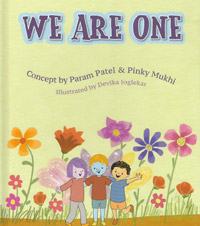 “We Are One” (38 pages; $14.95) by Param Patel and Pinky Mukhi; published by Mascot Books (www.mascotbooks.com)
“We Are One” (38 pages; $14.95) by Param Patel and Pinky Mukhi; published by Mascot Books (www.mascotbooks.com)
Six-year-old Mintu has invited his friends over for dinner. But he isn’t too sure about whether he should communicate with his mother in Gujarati or offer Indian food since “it is so different.” But his mother assures him, “Your friends love you for who you are, not what kinds of food you eat or what language you speak …” The three friends, Chirpy, Curio and Mintu, have different interests but realize that they are closer than ever after accepting their diverse backgrounds. Sure to instill children with pride for their own food, language and culture, this book celebrating diversity is a moving story that should lead to a meaningful dialogue with children of all ages. Author Mukhi was inspired to write the book after Param had been asking questions about differences between him and his friends while growing up in the United States. “We are brown. We are black. We are white. We are colorful. We come in different sizes. We come in different shapes. We speak different languages. We celebrate different festivals. We eat different food. We like different things. We are so different. We are friends. We help each other. We feel sad for others. We love each other. Love is something deep in us. We feel one with all we love. We are one in love,” reads a touching one-page note at the end. One couldn’t have said it any better.
COOKBOOK REVIEW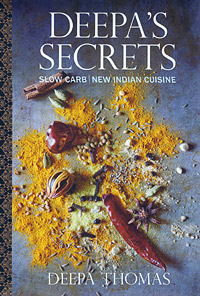
“Deepa’s Secrets: Slow Carb/New Indian Cuisine” by Deepa Thomas; 234 pages; $24.99; published by Skyhorse Publishing. (www.skyhorsepublishing.com)
It is no secret that India is the diabetes capital of the world with more than 50 million people suffering from type 2 diabetes, including the author’s husband, Thampy, of Indian origin. The culprits are rice and bread – two staples of Indian cuisine at the top of the glycemic index (GI: rating determined by a food’s ability to raise your blood sugar on a scale of 0 to 100). As soon as Deepa Thomas discovered the culprits, she dwelt into six months of cooking and eating “New Indian.” The result? The author of this well-written, invaluable book lost 20 pounds and freed her Thampy from a 10-year routine of insulin shots. No doubt, it isn’t easy to let go off carbohydrates such as rice, bread, potatoes and pasta, Thomas warns. Her solution is embracing foods high in nutrients and/or fiber and lower on the GI like whole grains, nuts, berries and leafy green vegetables more often, every 2-3 hours. The first two weeks of a slow carb lifestyle are tough but things get better, she assures you. “What I’ve invented, or reinvented, is Indian low carb or slow carb cuisine. Not no carb, which emphasizes fat consumption.” In the 70 recipes of the book, which is interspersed with interesting anecdotes from her childhood, the author advises using gut-healthy ingredients like beans, cabbage, mushrooms, leeks, blueberries, yogurt, etc. The founder of the now-defunct Deepa Textiles, who is also a painter and journalist, hopes “my food, your food, gives you great pleasure and good health, and that your healthy choices free you to find, do, be, and feel your best. That’s everything. Except the carbs.” But, of course.
Here are two of the recipes reproduced with permission from the publisher:
Aviel
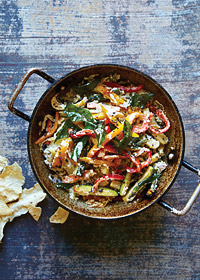 Aviel is Malayalam for vegetable medley. It is the celebration dish in Kerala. I kept the concept, but I didn’t feel the need to cook it to a mush-like consistency. This vegetable medley is al dente—a lot faster, a lot fresher, and every bit as festive.
Aviel is Malayalam for vegetable medley. It is the celebration dish in Kerala. I kept the concept, but I didn’t feel the need to cook it to a mush-like consistency. This vegetable medley is al dente—a lot faster, a lot fresher, and every bit as festive.
SERVES 4
Yogurt dressing:
- 2 cups grated coconut (thawed if frozen)
- 1 cup water
- 1 tablespoon cumin seeds, toasted and ground
- 1 jalapeño, rough chopped
- 1 tablespoon fresh ginger paste
- ½ teaspoon fresh garlic paste
- 1 cup Greek yogurt
Vegetables (cut into 2-inch sticks resembling French fries):
- 2 Yukon gold potatoes, peeled
- 2 cups string beans
- 1 carrot
- 1 zucchini
- 1 yellow, red, and orange bell pepper (3 in all)
Sauté:
- 1 tablespoon unrefined coconut oil
- 1 yellow onion (cut into 2-inch pieces resembling French fries)
- 6 curry leaves
- ½ teaspoon salt
- ½ teaspoon fresh ground black pepper
Tadka:
- 1 tablespoon unrefined coconut oil
- 1 teaspoon black mustard seeds
- 6 curry leaves
- 1 shallot, sliced
- ¼ teaspoon cayenne flakes
- 1 tablespoon unrefined coconut oil (melted over low heat) for finishing drizzle
- Puree yogurt dressing ingredients in a blender or food processor. Set aside.
- Vegetables: Blanch potatoes and beans in a large pot of salted boiling water for 2 minutes. Add carrots, blanch for 1 minute more. Add zucchini and bell peppers, blanch for 1 additional minute. Vegetables should be firmly cooked, not mushy! Drain.
- Heat coconut oil and sauté onion. When onion begins to brown, add curry leaves (protect yourself from crackling leaves, with a lid) and stir for 30 seconds. Add blanched vegetables and continue sautéing for 2 minutes. Don’t overcook! Season with salt and pepper.
- Add yogurt dressing to the sautéed vegetables and toss gently to avoid breaking up the vegetables.
- Tadka: Heat coconut oil in a large 12-inch saucepan over medium heat. Add mustard seeds and curry leaves (shield yourself from spluttering with a lid). Add shallot and stir until it begins to brown (5 minutes). Lower heat, and add cayenne flakes. Stir for one minute, and spoon tadka over the sautéed and yogurt-dressed vegetables.
- Drizzle with a final tablespoon of coconut oil as a flavor booster! Check seasoning. Serve warm or at room temperature.
Serve Aviel with Heritage Barley (Better than Rice) Pilaf, Ammachi’s Clay Pot Fish Molee and Peppery Papadum.
The humble onion promotes the growth of healthy gut bacteria, which is good for digestion, immune response, and brain function. The inulin in onion also stabilizes blood sugar levels, helping to control diabetes. Onions contain powerful antioxidants, and red and purple onions have anthocyanins (the same water-soluble pigments found in berries) with powerful anti-inflammatory and antimicrobial properties.
Smashed Chickpea and Toasted Peanut Cakes
 Vendors in Delhi used to toast peanuts on the streets during the cooler winter months. They’d light fires and warm the peanuts in their shells, then slip them into newspaper cones. The peanut-chickpea combo doubles the protein in this recipe for a great vegetarian meal, side, snack, or appetizer.
Vendors in Delhi used to toast peanuts on the streets during the cooler winter months. They’d light fires and warm the peanuts in their shells, then slip them into newspaper cones. The peanut-chickpea combo doubles the protein in this recipe for a great vegetarian meal, side, snack, or appetizer.
SERVES 6
Toast and grind:
- ¼ teaspoon anise seeds
- ¼ teaspoon cumin seeds
- ¼ teaspoon coriander seeds
- ¼ teaspoon fennel seeds
- 1 can (15 oz) garbanzo beans, drained and rinsed well
- 1 cup peanuts, shelled, toasted, and rough chopped (skin-on Indian peanuts are fine)
- 1 cup unsweetened shredded coconut
- 2 tablespoons onion, minced
- 2 tablespoons garlic, minced
- 1 jalapeño, minced
- ½ teaspoon garam masala
- 1 teaspoon chaat masala
- ¼ teaspoon cayenne powder
- 1 tablespoon mint leaves, stemmed and finely chopped
- 1 tablespoon cilantro leaves, stemmed and finely chopped
- 1 egg, beaten
- 1 teaspoon fresh lemon juice
- ½ teaspoon salt
- 1 cup coconut or chickpea (garbanzo) flour
- 1 tablespoon unrefined coconut oil
Make ahead: Cakes, cooked or uncooked, freeze beautifully for a grab and go snack, appetizer, or meal. Use parchment or waxed paper to separate layers before freezing.
- Toast and grind seeds. Mix all the remaining ingredients except for the flour and coconut oil. Use a hand blender to puree to a rough consistency. Check seasoning.
- Shape into 2-inch patties.
- Press patties into coconut or chickpea flour to help them hold their shape.
- Heat oil in a 10-inch nonstick skillet. Use enough oil to “moisten” the pan (about one tablespoon).
- Brown the cakes (several at a time, without crowding) over medium heat (about four minutes). Gently flip (I use two spatulas) and brown the other side (another four minutes). Repeat until all cakes are done. You may need to add oil between batches. Keep the finished cakes warm in a 200ºF oven until ready to serve.
- Serve with Reemsie’s Tamarind Sauce or Chutput Ketchup for dipping.
The chickpea and peanut cakes are a nice starter or accompaniment to Crackling Okra and Chukku’s Yogurt Salad.